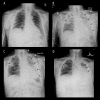Platypnea Orthodeoxia Due to a Patent Foramen Ovale and Intrapulmonary Shunting After Severe COVID-19 Pneumonia
- PMID: 34697281
- PMCID: PMC8559663
- DOI: 10.12659/AJCR.933975
Platypnea Orthodeoxia Due to a Patent Foramen Ovale and Intrapulmonary Shunting After Severe COVID-19 Pneumonia
Abstract
BACKGROUND Platypnea orthodeoxia syndrome (POS) presents with positional dyspnea and hypoxemia defined as arterial desaturation of at least 5% or a drop in PaO2 of at least 4 mmHg. Causes of POS include a variety of cardiopulmonary etiologies and has been reported in patients recovering from severe COVID-19 pneumonia. However, clinical presentation and outcomes in a patient with multiple interrelated mechanisms of shunting has not been documented. CASE REPORT An 85-year-old man hospitalized for hypertensive emergency and severe COVID-19 pneumonia was diagnosed with platypnea orthodeoxia on day 28 of illness. During his disease course, the patient required supplemental oxygen by high-flow nasal cannula but never required invasive mechanical ventilation. Chest imaging revealed evolving mixed consolidation and ground-glass opacities with a patchy and diffuse distribution, involving most of the left lung. Echocardiography was ordered to evaluate for intracardiac shunt, which revealed a patent foramen ovale. Closure of the patent foramen ovale was not pursued. Management included graded progression to standing and supplemental oxygen increases when upright. The patient was discharged to a skilled nursing facility and his positional oxygen requirement resolved on approximately day 78. CONCLUSIONS The present case highlights the multiple interrelated mechanisms of shunting in patients with COVID-related lung disease and a patent foramen ovale. Eight prior cases of POS after COVID-19 pneumonia have been reported to date but none with a known patent foramen ovale. In patients with persistent positional oxygen requirements at follow-up, quantifying shunt fraction over time through multiple modalities can guide treatment decisions.
Conflict of interest statement
Figures




Similar articles
-
Patent foramen ovale revealed by COVID-19 pneumonia.BMC Pulm Med. 2021 Apr 19;21(1):126. doi: 10.1186/s12890-021-01494-7. BMC Pulm Med. 2021. PMID: 33874930 Free PMC article.
-
Persistent hypoxemia and platypnea-orthodeoxia after left single-lung transplantation: a case report.J Med Case Rep. 2015 Jun 12;9:138. doi: 10.1186/s13256-015-0598-4. J Med Case Rep. 2015. PMID: 26065882 Free PMC article.
-
Platypnea-Orthodeoxia and Patent Foramen Ovale in a Patient in the Setting of COVID-19.Tex Heart Inst J. 2025 May 28;52(1):e248401. doi: 10.14503/THIJ-24-8401. eCollection 2025 Jan-Jun. Tex Heart Inst J. 2025. PMID: 40443791 Free PMC article.
-
Platypnea-orthodeoxia syndrome in the elderly treated by percutaneous patent foramen ovale closure: a case series and literature review.Eur J Intern Med. 2013 Dec;24(8):813-7. doi: 10.1016/j.ejim.2013.08.698. Epub 2013 Sep 3. Eur J Intern Med. 2013. PMID: 24007641 Review.
-
Platypnea-Orthodeoxia Syndrome: To Shunt or Not to Shunt, That is the Question.Tex Heart Inst J. 2016 Jun 1;43(3):264-6. doi: 10.14503/THIJ-15-5280. eCollection 2016 Jun. Tex Heart Inst J. 2016. PMID: 27303248 Free PMC article. Review.
Cited by
-
Platypnea-Orthodeoxia Syndrome in Coronavirus Disease 2019 Pneumonia: A Case Report and Literature Review.Int Med Case Rep J. 2023 Mar 27;16:201-207. doi: 10.2147/IMCRJ.S402537. eCollection 2023. Int Med Case Rep J. 2023. PMID: 37007669 Free PMC article.
-
Platypnea-orthodeoxia syndrome in SARS-CoV-2 related ARDS: a case report.Acta Biomed. 2022 Jun 7;93(S1):e2022102. doi: 10.23750/abm.v93iS1.12824. Acta Biomed. 2022. PMID: 35671104 Free PMC article.
-
Platypnea-Orthodeoxia Syndrome and COVID-19 Successfully Treated With Percutaneous Patent Foramen Ovale Closure: A Report of Two Cases and Literature Review.Cureus. 2024 Mar 21;16(3):e56655. doi: 10.7759/cureus.56655. eCollection 2024 Mar. Cureus. 2024. PMID: 38646276 Free PMC article.
-
Known to recognize: a rare case of dyspnea.Intern Emerg Med. 2024 Nov;19(8):2233-2235. doi: 10.1007/s11739-024-03654-z. Epub 2024 Jun 28. Intern Emerg Med. 2024. PMID: 38943035 No abstract available.
References
-
- Agrawal A, Palkar A, Talwar A. The multiple dimensions of platypnea-orthodeoxia syndrome: A review. Respir Med. 2017;129:31–38. - PubMed
-
- Akin E, Krüger U, Braun P, et al. The platypnea-orthodeoxia syndrome. Eur Rev Med Pharmacol Sci. 2014;18(18):2599–604. - PubMed
-
- Gadre A, Highland KB, Mehta A. Reversible platypnea-orthodeoxia syndrome from ventilation-perfusion mismatch in interstitial lung disease: A novel etiology. Ann Am Thorac Soc. 2016;13(1):137–38. - PubMed
-
- Bellato V, Brusa S, Balazova J, et al. Platypnea-orthodeoxia syndrome in interatrial right to left shunt postpneumonectomy. Minerva Anestesiol. 2008;74(6):271–75. - PubMed
Publication types
MeSH terms
LinkOut - more resources
Full Text Sources
Medical

